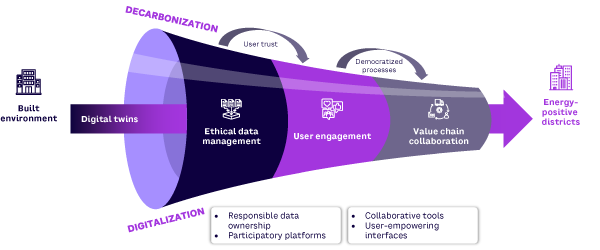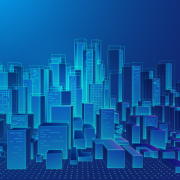This Advisor draws on the authors’ experience with Syn.ikia, an EU-funded Innovation Living Lab for positive-energy building districts that leverage energy efficiency and renewable energy sources. Digital innovations like digital twins have been essential to unlocking positive-energy districts. In Uden, the Netherlands, the digital twin combines a virtual model for the building and its installations with an AI model that simulates user behavior and other dynamic factors (e.g., energy use, environmental conditions, and system performance). Syn.ikia’s partners are implementing this predictive twin in a model predictive controller to optimize excess on-site solar energy.
Lessons Learned
Below are some key learnings from the Uden pilot. Some insights trace back to when the future inhabitants of the Uden neighborhood were first informed about the upcoming digital twin implementation. Others came later, when we cocreated possible approaches with project partners and present and future stakeholders to responsibly manage this technology at the intersection of digitization and sustainability.
Ethical Data Management Is Key
Imagine a winter day with a sudden drop of -10 degrees Celsius. You feel cold, reach for a blanket, and decide to increase your home’s indoor temperature. When your home runs on gas boilers, you can turn on the heat by rotating a radiator valve or thermostat. You feel the radiator’s warmth within minutes. If your home runs on sustainable energy and is heated through a geothermal heat pump, it may take hours to days to increase the temperature, depending on your system’s capacity, your house’s insulation, and the speed of the outside temperature drop.
If your home has a digital twin, you might not even realize the temperature had dropped and be surprised at how cold it is when you go outside. A predicting twin connected to a weather station knew there would be a temperature drop for a few days, and it slowly but steadily (hence, efficiently) heated your home to prepare for the temperature change. Digital twins can significantly reduce buildings’ emissions by better preparing for future energy demands while ensuring comfort. The problem is that they need data (lots of data) to work.
Imagine you spend only a few hours at home and return home around the same time every day. Your digital twin knows you usually boil water at 6 pm, shower shortly after that, then turn on all the lights, the TV, the oven, and 60% of your other electrical devices. Knowing there will be a rise in energy demand coming from your apartment, the digital twin can prepare for your arrival while efficiently managing your energy demand and that of your neighbors. To do so, the digital twin needs to thoroughly understand the daily behaviors of those in the building.
Now imagine energy service companies have access to this data and are directly or indirectly managing the digital twin. These insights might impact energy pricing and energy contracts. In a world run by renewables, where energy supply is sustainable but unstable, flexible energy pricing is becoming more common.
Clearly, data protection must be a priority when implementing a digital twin, and the EU is working to ensure regulations keep pace with this fast-moving technology. But companies must also store and process data safely, something they are currently ill-incentivized and ill-equipped to do. As buildings become more digitized, there is a pressing need to protect users by making them aware of traceability risks and potential unethical implications, which leads to the next point.
Do Not Forget the End User!
User-centric design is not new. Over the past 50 years, design has become increasingly user-led, user-driven, and user-centric. Architects and engineers have made significant strides in democratizing design, minimizing technocracy, and significantly reducing disempowering practices, something recognized as even more crucial to achieving sustainability outcomes in the built environment. Nevertheless, digital twins may inherently limit user freedom by turning building management into an expert-only practice by sidelining nonexperts (i.e., disempowering them from engaging with and influencing the environments they inhabit).
Currently, digital twin developers are not framing this innovation as socio-technical, focusing instead on technical interactions. This is somewhat puzzling but not surprising. The advent of smart buildings (in which IoT sensors automate systems like HVAC, lighting, and security) led to many users expressing frustration about losing control over simple tasks like adjusting curtains or heating. They are forced to rely on automated decisions made based on an average demographic that doesn’t reflect individual preferences.
Digital twins still lack user-friendly interfaces. This may lead to users feeling alienated from their environments, reducing their sense of ownership and satisfaction. To truly empower users, digital twin development must prioritize intuitive interfaces and personalized control over automated systems. There’s also a need to design platforms that foster community-driven solutions, empowering inhabitants while simplifying building management for all. But this cannot be achieved by one actor alone and requires coordinated efforts across the entire building value chain.
Make It Value Chain–Proof
The building industry is notoriously fragmented. Components, systems, and stakeholders often don’t work together as smoothly as designs demand. This lack of integration can result in projects that seem patched together rather than cohesive solutions. We might fix glaring short-term problems with minimal effort, but long-term issues like faulty installations or poor insulation could remain invisible for years, if not forever, negatively impacting the actual energy performance and CO2 emissions of buildings.
Unfortunately, learning from past mistakes isn’t part of the industry’s DNA. Companies in the construction sector rarely analyze what went wrong on previous projects, and even less frequently do they share feedback across teams, organizations, and stakeholders. In an industry driven by deadlines and budgets, solutions that could lead to better designs are often lost in the shuffle. Without a feedback loop to improve on past experiences, digital twin technology risks reinforcing silos rather than breaking them down.
To make digital twins value chain–proof, they must become real-time learning and collaboration tools. They need to bring together all stakeholders (architects, contractors, engineers, users, and maintenance teams) to ensure everyone is reading from the same playbook. If we can close the feedback loop, we’ll create systems that adapt and improve with every project, helping us spot potential failures before they happen and use data to guide better decision-making. Only then can digital twins benefit the entire value chain by fostering collaboration and continuous improvement (see Figure 1).

[For more on Syn.ikia, see: “Digital Twins & Sustainability: A Pathway to Building Positive-Energy Districts”.]




